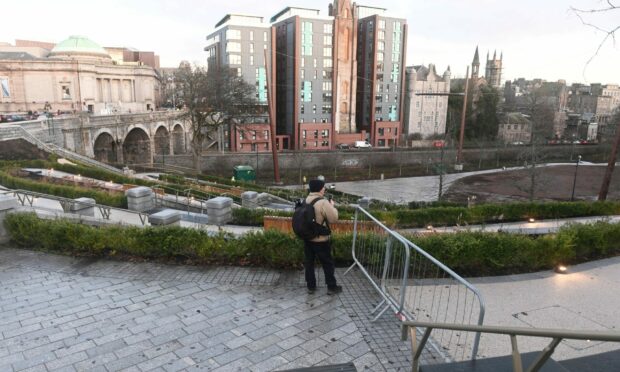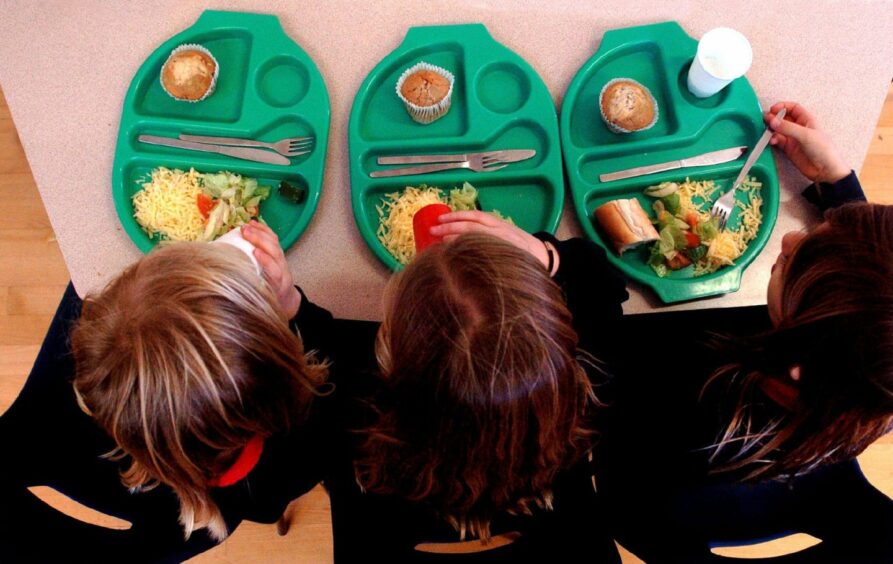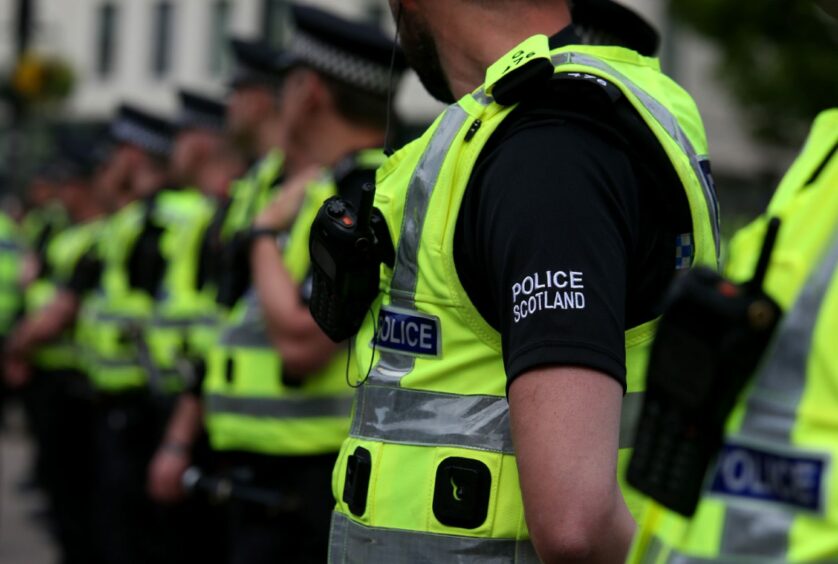Sir, – It’s not just a row over the quality of the lime mortar pointing we should be concerned about with the Union Terrace Gardens saga. Unfortunately, we have lost a truly original piece of northern public space and it’s a final blow for the once rich full identity of the Granite City.
The finished product is a double insult, not only to Sir Ian Wood but to the people of Aberdeen.
Building and public space is culture. It represents more about a society and people than even words and images can. It is immediate, unavoidable and a mark of its epoch. The £30 million project is less of a refurbishment but more a form of vandalism, petty vandalism on a city scale, at that. It starts with the out-of-scale “pavilions” lining Union Terrace to the cheap-looking “golden” railings and bins throughout and the already rust-stained ramp.
There is no denying there were problems with Union Terrace Gardens, however, it had character and reinforced the engineering marvel of the Union Street viaduct project of the early 19th Century, the largest engineering project in Europe at the time, and the Union Bridge still holding the world record for the largest single-span granite bridge.
It reminded the inhabitants of Aberdeen of the natural topography which was dominated by the ingenuity and amusingly effortless handling of a material such as granite.
Do we really believe the social problems previously associated with the park can be solved by removing more green space from the city, to still have no real function for the arches, while most of Union Street stands vacant and looking more derelict by the year, to have a useless hanging donut over where one can only assume the future Thunderdome will be built? It cannot even be called dystopian, as at least dystopia has connotations of a utopia and positive future.
Later generations will hold us accountable for this mess and short-sightedness. The charm and identity of the city has been slowly eroded over the last 20 years, from the cheap Chinese granite (of no relation to Rubislaw granite), the out-of-scale and economically-built carbuncles of recent commercial and residential projects notwithstanding the shopping centres.
How many more mistakes are to be made in destroying the image of a city?
A. Mackintosh.
New year resolution urgently needed or Union Street could die
Sir, –As the year 2022 slips away, we can look forward with hope that 2023 will be an improvement from the dreadful events that were part of 2022.
Locally, I understand that the meeting held in the Douglas Hotel last month where 170 members of the Aberdeen business community, (no public present) formed a coalition group to “save Union Street before it dies”, as reported in The P&J on December 20.
It would appear that much energy has been given to this subject and there is much merit in trying to solve the problem. Certainly, there are a number of interesting ideas revealed as part of the coalition’s plans, and of course these could take some time to achieve.
There is no doubt that Union Street needs sprucing up with a “general tidy up” as suggested by the group, involving removing weeds, having doors and windows repainted and “tired granite facades” being scrubbed.
Also, to “aesthetically improve” the Back Wynd stairs leading to the Green, with a deep clean, a living wall, and fairy lights. One short-term solution which Aberdeen Inspired is working on is to improve the look of vacant premises on Union Street. Under the scheme, businesses and organisations are to be encouraged to “adopt” a vacant unit and transform its exterior.
Much of what is suggested by the coalition group makes it appear as if these problems have just happened, when in fact Aberdeen Council could, and indeed should have, done something about cleaning up Union Street long before now.
Likewise, getting in touch with the property companies and pension funds who own the vacant units on Union Street, and legally getting them to sort out their properties.
It is so sad, but according to so many retail analysts city high street shopping has been in decline for many years, certainly as far back as when online shopping took off, back in the 1980s, long before the pandemic struck. Online shopping was valuable, and still remains so.
There’s also the convenience of Aberdeen’s retail parks at the beach area and Union Square, and the many out-of-town shopping centres with free parking, indeed so valuable that the council have just increased car parking charges and parking permits – a good reason for many people not to shop in town, and Union Street could die.
Ken Watmough. Broomhill Terrace, Aberdeen.
Free school meals sets bad example
Sir, – With some alarm I read the headline “Union blasts delay in free school meals”, (The P&J December 27) and an article where teaching leaders condemned the “shameful decision” by the Holyrood government to delay the rollout of free school meals to all primary pupils in a move that “runs contrary” to efforts to tackle child poverty.
In contrast to this view may I commend the sensible decision to delay and hopefully abandon such an action. Scotland thankfully is not a nation where all children are living in poverty, the great majority live in homes where parents, although having to be more careful in managing family budgets, are more than able to pay for their children’s meals.
It is sad to watch our country slipping into the quicksand of dependency, more and more, the substance of our daily existence expected to be free, families becoming as addicted to free this and that as the alcoholic to their next can of strong lager or addict to their next fix.
But nothing is really free, somebody has to pick up the bill and those who do are insufficient in number to meet this obligation.
This number will further decrease due to increases in those of working age who are absent through long-term sickness and others, who in the opinion of someone who worked until aged 72, choose to retire at a ridiculously young age.
Our government in Holyrood must realise that those, even octogenarians like me, who can afford to pay for the necessities and pleasures of everyday life must do so. A “free for all” lifestyle is no longer affordable.
Ivan W Reid. Kirkburn, Laurencekirk.
Independence is not nationalism
Sir, – David Philip (Letters, December 29) has some cheek and his assertions need thoroughly challenged.
His underhand attempt to portray unionism as a benign patriotism pitted against an “arrogant philosophy leading to war” is seen through as clear as day – it’s apples and oranges.
The selected post-war quote from 70 years ago is only one person’s view on an issue of semantics. I say that because there is more than one definition of nationalism and none of them relate to the modern independence movement.
It’s very deliberate, this corruption of the main party’s historical name by its enemies. The Brownshirt right-wing nationalism of the early 1930s would get zero traction in the current SNP.
Remember the name is National and not Nationalist, despite what Westminster’s Tories deliberately and persistently troll Scots MPs with.
Let’s come back, though, to his tilt at patriotism and pride. Part of the reason Scots have pride in their country is because of its achievements. “Of all the small nations of this Earth, perhaps only the ancient Greeks surpass the Scots in their contribution to mankind,” said that icon of Mr Philip’s beloved UK, Winston Churchill.
Basically, what Mr Philip’s case boils down to is that his Anglo-British nationalism is better than anything else while projecting that exceptionalism onto a democratic self-determination movement backed by most Scots. It’s a horrible argument and never do I hear the Yes supporters claim their country is better at anything – we just want it to be normal and self-governing. Contrast and compare with the jingoistic boosterism we see from the Tories in particular. World-leading “this and that”.
If childish name-calling without substantiation is the best Mr Philip can do, we have little to fear.
Peter E Smith. Aigas, Beauly.
Life-threatening decline of police
Sir, – While I welcomed your article regarding the severely depleted police services in the Highlands, I would have to point out that the current situation has been in place for some time.
I have engaged with politicians many times now and also wrote to your paper some two years ago highlighting this disgraceful and downright dangerous state policing is in since the inception of Police Scotland.
At one stage I was copied into correspondence from the then Justice Secretary Humza Yousaf, intimating there were more than 2,500 police officers available in the Highlands and Islands. This was a downright lie, and as you know he has refused to release the real figure to your own publication.
I was a serving officer in Northern Constabulary for 30 years, retiring as superintendent and at no time did the establishment of officers exceed some 715. That figure is considerably less now, with many officers having to undertake office duties since the removal of support staff from front office duties.
That said, I am unaware of a single police office now in the Highlands that is accessible to the public as the front doors remain locked most of the time. On many occasions, only two officers cover the entire land mass of Easter and Wester Ross. There are no police offices now remaining on the A9 north from Tain through to Wick, the main trunk road north, which was the scene of multiple deaths in severe weather conditions some years ago. Indeed, I am unaware of any police offices open anywhere in Sutherland, the largest county in Scotland. Dornoch now has no police office and no court.
In a geographical comparison, if one places a compass point on Inverness and the other on the north tip of Shetland the resulting arc reaches just south of Birmingham, such is the mass covered by what once was the responsibility of Northern Constabulary.
The current situation in the north is life-threatening and is exposing officers to injury or worse on a daily basis.
I sincerely hope no officer ever comes to harm but if it happens I will be first voice the politicians and senior command will hear calling them out, while they all dive for cover.
Charles S Hepburn. Former superintendent, Birch Drive, Maryburgh, Dingwall.
Politics to blame for failure of NHS
Sir, – The opinion piece by Euan McColm (The P&J, December 30) is headed “We need to talk about the NHS with cool heads and open minds”. I agree with his sentiment but not perhaps with his definition of an open mind.
In his piece he states “And how has the Scottish Government responded to new challenges? Very badly I’d say”. He then goes on to say that “Since then, under the stewardship of the SNP, the Scottish NHS has been rather neglected.”
This approach will raise the hackles of SNP supporters. I have seen no evidence that any political party or health secretary would have done anything different with better outcomes.
I am not a member or active supporter of any political party. I believe that politics can act to the detriment of the NHS. The conversation must also be about social care which is now an integral part of primary care.
The fact that there are two major employers in health and social care partnerships, the NHS and local authorities, is just plain daft and leads, for example, to the disparity between the wages of a health care assistant and the much lower-paid carer in the local authority setting, while the job can be broadly similar.
Derek Feeley wrote an excellent report into the future of care in Scotland. It foresaw an amalgam of public and private provision. This report cannot get cross-party support because of dogmatic opposition to what is perceived to be centralisation.
Health and social care partnerships are currently constrained by a lack of financial transparency and the input of health boards and councils. Dr Kennedy, of the BMA, in his appeal for a conversation to start, stated that the NHS was broken. I think he’s correct.
Public engagement will be an essential part of the conversation. This has gone backwards with the change from community health partnerships to health and social care partnerships. In the former, the public had a statutory voting role, in the latter it tends toward the tokenistic.
We need to agree a way forward, the role all staff, private and public, play and the appropriate remuneration for that role.
We also need to better define the relationship between government, the civil service, chief executives and boards.
This will require a lot of careful planning and money but we must not be frightened by this prospect and we should keep applying the sticking plasters to retain the staff and keep the NHS functioning in the meantime.
Any more than that, is a waste of money.
Robin Creelman. Argyll.



Conversation